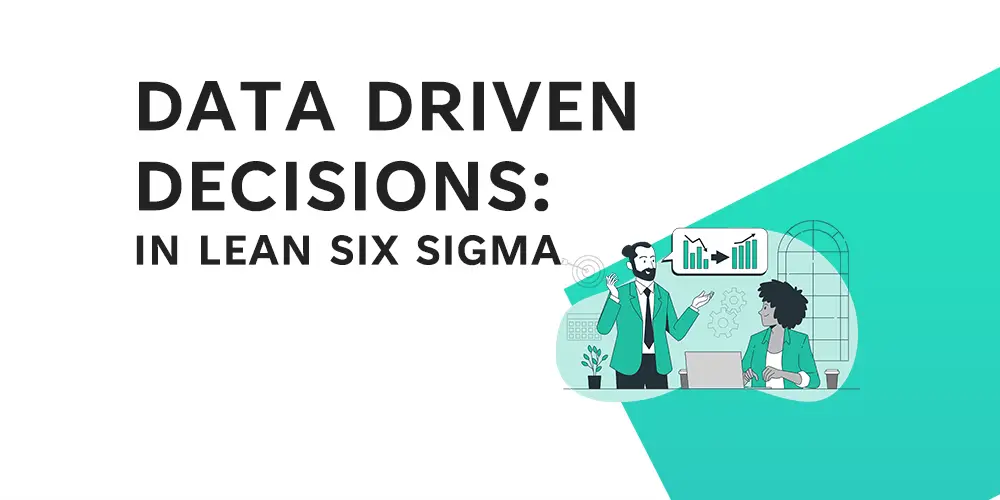Organizations are constantly under pressure to make informed decisions quickly and effectively in today’s fast-paced business environment. Lean Six Sigma is a data driven process improvement methodology that assists organizations in achieving this goal by providing a framework for making data driven decisions.
Data driven decision making is an important part of the Lean Six Sigma methodology because it ensures that decisions are based on objective data rather than subjective opinions or assumptions. Organizations can identify the root causes of problems, measure the impact of process changes, and make informed decisions that lead to improved business outcomes by using data to drive decision making.
This blog post will look at the significance of data driven decision making in Lean Six Sigma. We will define data driven decision making, explain why it is important in Lean Six Sigma, and demonstrate how to make data driven decisions in Lean Six Sigma. We will also discuss some of the most common challenges in data driven decision making and provide examples of how organisations have overcome these obstacles. By the end of this post, you will have a firm grasp on the role of data driven decision making in Lean Six Sigma and how to implement it in your own organisation.
Table of Contents
What is Data Driven Decision Making?
The process of making decisions based on objective data rather than subjective opinions, assumptions, or biases is known as data driven decision making. It entails gathering, analysing, and interpreting data in order to make informed decisions based on facts rather than intuition or experience. Data driven decision making is used in the context of Lean Six Sigma to identify opportunities for process improvement, measure the impact of process changes, and make data driven decisions that lead to improved business outcomes.
How Data Driven Decision Making Differs from Other Options
Data driven decision making is distinguished from other decision making processes by its reliance on objective data rather than subjective opinions. Other decision making processes, such as intuition based decision making, are guided by personal experience, beliefs, or biases. While intuition based decision making has its uses, it is not as reliable or accurate as data driven decision making.
When making decisions, humans frequently rely on their own opinions and experiences. This is due to the fact that humans tend to trust what they know and have experienced in the past. These factors can have an impact on their decision making processes as well as their beliefs and attitudes.
However, relying solely on one’s own opinions and experiences can lead to poor decisions. This is due to the fact that opinions and experiences can be skewed and may not accurately reflect the reality of a situation. People’s ability to make informed decisions may also be hampered by a lack of experience or knowledge.
Data driven decision making comes into play here. Data driven decision making entails identifying patterns and trends in data and statistical methods and making decisions based on evidence rather than opinion or experience alone. Organizations can gain insights into the performance of their processes and identify areas for improvement by using data.
Data driven decision making can help reduce bias and provide objective insights into a process or system’s performance. This can result in better informed decisions, increased efficiency, and increased profitability. As a result, while it is natural for humans to make decisions based on their opinions and experiences, it is critical to recognise the limitations of this approach and to incorporate data driven decision making into the decision making process whenever possible.
Another type of decision making process is rule based decision making, which involves making decisions based on predetermined rules or guidelines. While rule-based decision making can be useful for routine or simple decisions, it may not be effective for more complex decisions requiring multiple variable analysis.
Data driven decision making differs from reactive decision making, which occurs in response to a problem or crisis. Reactive decision making can result in quick fixes, but it may not address the underlying causes of the problem, leading to recurring issues.
Examples of Decisions Made with Data
Here are some examples of data-driven decision making:
- A manufacturing company monitors a critical manufacturing process using statistical process control (SPC) charts. If a process is out of control, the company investigates the root cause and takes corrective action to bring it back under control.
- Patient satisfaction surveys are used in hospitals to identify areas for improvement. The hospital collects and analyses survey data to determine the root causes of dissatisfaction and creates action plans to address the issues.
- A/B testing is used by a marketing department to determine the most effective marketing campaign. The department develops two versions of the campaign and randomly distributes each to a subset of customers. The version with the most conversions is chosen as the final campaign.
Data is used to drive decision making and improve business outcomes in all of these examples. Organizations can identify areas for improvement, measure the impact of changes, and make informed decisions that lead to increased efficiency, effectiveness, and customer satisfaction by using data to make decisions.
Why Data Driven Decision Making is Important in Lean Six Sigma
To achieve its goals of process improvement and waste reduction, Lean Six Sigma is a methodology that heavily relies on data-driven decision making. Lean Six Sigma emphasises data collection and analysis to identify root causes of problems, measure the impact of process changes, and make data-driven decisions that result in better business outcomes.
Data is used to guide decision making in Lean Six Sigma throughout the entire process improvement cycle, from identifying opportunities for improvement to maintaining the gains made. Statistical process control, root cause analysis, and process mapping are among the tools and techniques used to collect data. The information is then analysed to identify trends, patterns, and areas for improvement.
What are the Benefits of Data Driven Decisions in Lean Six Sigma
Using data-driven decision making in Lean Six Sigma has several advantages, including:
Improved accuracy: Data-driven decision making reduces the reliance on intuition, assumptions, and opinions, which can be influenced by personal biases and experience. Decisions are based on facts and are more accurate when objective data is used.
Faster decision making: Data-driven decision making can reduce decision-making time by providing objective and relevant data that can be used to quickly identify areas for improvement and make informed decisions.
Increased efficiency: By identifying waste and inefficiencies in processes and making changes that result in streamlined operations, data-driven decision making can lead to increased efficiency.
Increased customer satisfaction: Data-driven decision making can assist organisations in identifying customer needs and preferences and making changes that result in increased customer satisfaction.
Examples of Sucessful Lean Six Sigma Projects Due to Data
Here are some examples of how Lean Six Sigma projects can be sucessful by relying on data-driven decision making:
- A manufacturing company reduced product defects by using statistical process control charts and data to identify the root causes of defects.
- A hospital improved patient satisfaction by identifying areas for improvement and developing action plans based on data from patient surveys.
- A financial services firm reduced loan processing time by using data to identify inefficiencies in the loan approval process and making changes that resulted in a more streamlined process.
Data-driven decision making was critical in identifying opportunities for improvement, measuring the impact of changes, and making informed decisions that resulted in improved business outcomes in all of these examples.
How to Make Data Driven Decisions in a Lean Six Sigma Project
What is the Process in Making Data-Driven Decisions
Making data-driven decisions in Lean Six Sigma typically entails the following steps:
- Determine the issue or opportunity for improvement.
- Define the project’s scope and the metrics to be used to assess success.
- Collect data relevant to the problem or improvement opportunity.
- Analyze the data to find trends, patterns, and the underlying causes of problems.
- Based on the data analysis, create and implement solutions.
- Keep an eye on the process to ensure that the gains are sustained over time.
Collecting and Analyzing Data
Lean Six Sigma practitioners employ a variety of tools and techniques to collect and analyse data. Surveys, observation, and statistical sampling are all common data collection methods. Data must be collected and analysed in order to identify trends, patterns, and root causes of problems. This analysis may employ statistical methods such as regression analysis and hypothesis testing to aid in the identification of relationships and patterns in the data.
Why its Important to use Statistical Tools for Data Analysis
Statistical tools are an important part of data analysis in Lean Six Sigma. They enable practitioners to identify patterns and relationships in data that may not be obvious at first glance. Statistical tools can assist in determining the root causes of problems, measuring the impact of process changes, and providing a foundation for data-driven decisions.
Among the statistical tools commonly used in Lean Six Sigma are:
Pareto charts are bar graphs that show the relative frequency or size of problems in decreasing order of importance. It is used to identify the most critical issues that must be addressed.
Control charts are used to track a process over time and identify when it is out of control or not meeting performance standards. They are frequently used to monitor the quality of products or services in manufacturing and healthcare.
Regression analysis is used to identify the relationships between variables and to make future predictions based on those relationships. In Lean Six Sigma, it is frequently used to identify the factors that are most strongly correlated with a specific outcome.
Hypothesis testing is used to determine whether a specific hypothesis about a process is supported by data. It is frequently used in Lean Six Sigma to determine whether a specific improvement had a statistically significant impact on a process.
Lean Six Sigma practitioners can make informed decisions based on objective data rather than intuition or assumptions by using statistical tools in data analysis. This results in more accurate and efficient process improvements and, as a result, better business outcomes.
Common Challenges of Making Data Driven Decisions
Data collection and analysis can be a difficult process. Among the most common difficulties are:
- In some cases, organisations may lack sufficient data to make informed decisions. This can happen when a process is new or when data collection processes are inefficient.
- Inadequate data quality inaccurate, or inconsistent data can lead to incorrect conclusions and decisions. This could be due to errors in data entry, data collection methods, or other factors.
- Bias occurs when data is collected or analysed in a way that favours one outcome over another. For example, if a company wants to demonstrate the success of a new product, it may only collect data from satisfied customers.
How to Overcome these Challenges
There are several approaches to overcoming these obstacles in data-driven decision making:
Create a data collection plan: Before collecting data, create a plan outlining the data to be collected, the methods for collecting it, and the timeline for collecting it. This can aid in the collection of data in a consistent and meaningful manner.
Improve data quality: Organizations can implement data validation and verification procedures, use automated data collection methods, or invest in data cleaning tools and processes to improve data quality.
Address bias: Organizations can address bias by ensuring that data is collected and analysed in an objective and unbiased manner. This can include utilising third-party data sources, involving multiple stakeholders in data analysis, and employing statistical methods to detect and correct bias.

To support with your Data collection support your project with free to download Data Collection Plan
Concluison
To summarise, data-driven decision making is an essential component of Lean Six Sigma. Organizations can identify opportunities for improvement, optimise processes, and reduce waste by using data to inform decision making. While data-driven decision making can be difficult, organisations can overcome these difficulties by developing a data collection plan, improving data quality, addressing bias, and analysing data with statistical tools.
Organizations can reap the benefits of data-driven decision making, such as increased efficiency, improved customer satisfaction, and increased profitability, by doing so. Finally, data-driven decision making is an essential tool for organisations seeking continuous improvement and a competitive advantage in today’s rapidly changing business environment.








